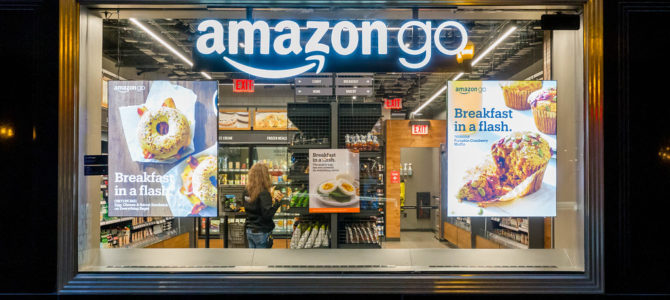
When I quit my summer job at a pharmaceutical plant sticking labels on jars falling off a conveyer belt and decided to take a job at Amazon as a Prime shopper, I knew little of what to expect. It was better pay and closer to home, and that’s all that mattered.
So on a humid day last August, I drove to a Whole Foods grocery store for orientation. Employees stood outside glued to their cell phones, smoking, adjusting face masks in boredom.
There was a cardboard box with yellow Amazon vests. I took one and unwrapped the thin cellophane cover, then went through the automated doors toward the back of the store where employees pack orders that appear on their work phones.
The first day of a job is typically when a supervisor introduces a new employee to the mechanics of a workplace, whether this means showing how to “clock in” and “clock out,” introducing him to others, or discussing expectations. While I was not expecting a full-on Gordon Ramsey-like tutorial upon getting hired at a major corporation lugging groceries, I was thrown off guard when I found out the entirety of orientation was to be done on a barely operational iPhone.
After waiting close to 30 minutes and making small talk with the employees starting that day — a mom who needed to pick up some hours, a young woman in nursing school, a man laid off from doing demolition work, and so on, we realized something was missing. There was no one leading us through any sort of orientation. The shoppers and forklift operators trudged along doing their work and no one seemed to notice us. Delivery drivers piled in and out, scanning stickered paper bags.

Eventually, a woman found some directions left for the group on an iPad. One by one, we new hires filled out our information and grabbed one of the Amazon work phones piled atop one another in the cabinet. The cabinet had a QR code and we scanned the phones to begin virtual orientation.
I looked up and saw dozens of others swiping and tapping, a sea of translucent glass and dozens of blue masks scrunched up to below the eyes. The entirety of the position was to be explained on the device, we learned.
I played a simulation game where I picked up bags and took them to the designated refrigerator, cabinet, or freezer area. I learned how to pack items in the bagging area by taking quizzes, and then an assessment. An Alexa voice congratulated me upon each question I answered correctly.
Whoever crafted the orientation, if in fact software did not automate it, did not account for technological difficulties. The senior woman next to me got to a portion of the training and had no idea how to proceed. She told me she was bad with technology and expecting at least one human soul to show her how to do a simple job. Then, like dominos, everyone else was on the same screen. The phones were malfunctioning.
I looked up from the phone and went over to an office to see if I could get some assistance on how to log into one of the trainings, on “diversity” of all things, since my provided login credentials were getting an error. A man folding boxes in the office was swiping on his own assigned work phone.
The phones are used for everything, and supervisors message staff members with instructions daily, the man told me. All employees grab one at the beginning of a shift and leave it in the cabinet afterward. I asked if he had any idea how to fix my glitching device and he said he didn’t. I asked if a supervisor was in, but he said no. He shrugged his shoulders when I followed up wondering when the last time a supervisor made it to the office.
Orientation at Amazon was a glimpse into working at a place where staff is treated like robots. I would have left that day with little knowledge of how to effectively complete my work, but luckily a guy my age showed me and it took all but 15 minutes. It is, of course, not rocket science to learn how to shop and pack orders. But automation made the whole experience more difficult, eliminating invaluable human interaction.
Automation in the workplace not only fills job spots of Americans willing to work, but it contributes to the erosion of civil society. “The growth of big business and the consolidation of industry, like other forces of centralization, tend to erode civil society and local communities,” writes Timothy P. Carney in “Alienated America.”
It’s why close to 30 percent of Amazon employees in Bessemer, Alabama sought to unionize. Aside from the workers describing hazardous conditions, which I can neither confirm nor negate, delivery drivers lamented being tracked by artificial intelligence-powered cameras in vans. “They were frustrated with how Amazon constantly monitored every second of their workday through technology, and they felt that their managers were not willing to listen to their complaints,” The New York Times reported.
Scheduling was also a concern for Bessemer employees, which I concur with given I never met with a supervisor to ensure I was able to obtain a suitable amount of weekly hours. Rather, scheduling is done via an application called Amazon Moment. Hours go live at different parts of the day and get nabbed instantly. Employees are promised the opportunity to get in a healthy amount of hours but automation makes it difficult to properly do so. The app glitched constantly.
The union was struck down in Alabama. Employees said Amazon’s environment “works against building solidarity and a willingness to invest in that employer and that job.” As a former employee, I would agree.

In the 6-months of working at Whole Foods, staring at a phone and walking around to scan overpriced packages of tofu and organic this or organic that, I met my supervisor maybe three times max. The woman was hired months into my employment, and the first man I never met. I never learned his name either.
When I took my lunch break, I would click a button on my work phone and wait for a notification to remind me when to come back. For Christmas, they shipped t-shirts for employees. No one ever really opened the box but a few people, and I don’t think anyone knew who sent it. On my last day, I took one. It says Amazon on it in five different places.
The point of a job is to get paid. There is no secret in that. But one important outcome of working at a people-oriented company is the ability to foster relationships with other individuals and learn from others how to get better.
On the contrary, Prime shoppers are forced to learn from a glass screen. Walk around a given store and you will see dozens of them maneuvering around, bumping into the aisles, waiting for the next instruction from the software.
Is the software efficient for the task? In some respects, yes. Given that the grocery lists appear on the work device and continue to do so throughout the day, it is unclear how else the hundreds of orders would be filled.
There is certainly a give-and-take in any situation and this is one of them. But even though I am no logistics coordinator, something is missing in Amazon’s virtual approach.
Corporate environments like Amazon, contrary to what Big Tech would like you to believe, stifle innovation by only relying on technology to be the intermediary for relations. Technology has its undeniable benefits in the workplace, but a sweeping reliance leaves people alienated, stripped of a common purpose and motivation to be loyal to their employer.







